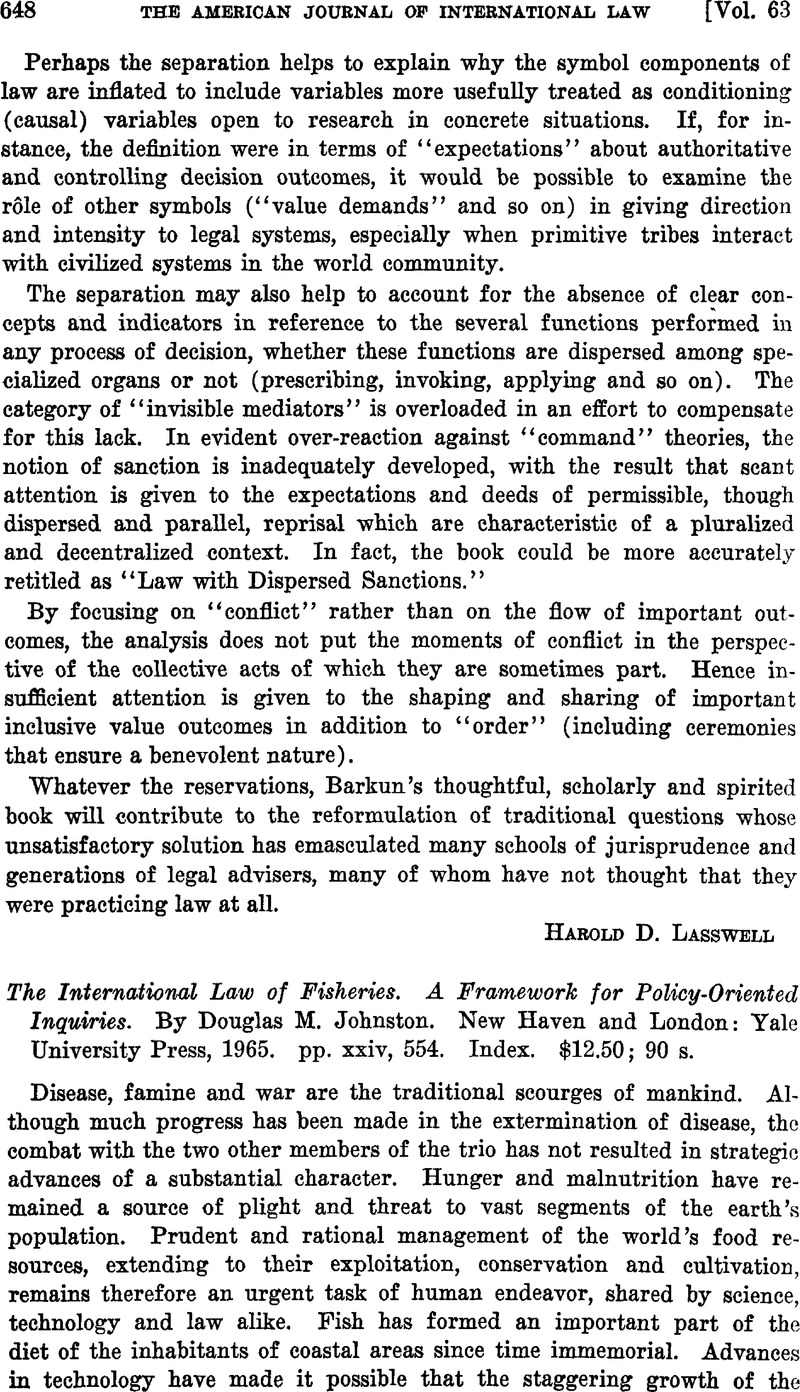No CrossRef data available.
Published online by Cambridge University Press: 28 March 2017

1 U.N., Demographic Yearbook 1967, World Summary, at p. 97.
2 F.A.O., 24 Yearbook of Fishery Statistics (1967), Table A2-1, p. a-68. The greatest increase was in the catch of landed herring which rose from 4.6 million metric tons to 19.6 metric tons.
3 Ibid., p. b-57. 9.8 million metric tons consisted of herrings, sardines and anchovies.
4 Ibid., p. b-73. Japan's catch was quite diversified, cods and haddocks being the largest category.
5 Ibid., p. b-152. Cods and haddocks: 2.1 million metric tons; herrings, sardines, anchovies: 1.3 million metric tons. Mainland China is reported to have a catch equaling the size of that of the U.S.S.B., 30 Commercial Fisheries Eev. 68 (Dec. 1968).
6 F.A.O., 24 Yearbook of Fishery Statistics (1967), p. b-122. Herrings, sardines, anchovies: 1.2 million metric tons.
7 Ibid., p. b-36. Herrings, sardines, anchovies: .6 million metric tons; tunas: .16 million metric tons.
8 See U.N., Economic and Social Council, The Protein. Problem, Report of the Secretary General, Oct. 1, 1968 (Doc. E/4592), especially No. 71-82. Unfortunately 98 percent of the marine fish caught by Peru are used for fertilizer and fish oil and not human consumption, ibid, at 25.
9 For a discussion of this scholarly skirmish, see Nys, Les origines du droit international 383-387 (1894); Riesenfeld, Protection of Coastal Fisheries Under International Law 10 (1942).
10 Riesenfeld, op. cit.
11 See Johnston, p. 511.
12 Johnston, p. 15.
13 Ibid, at 17. The distinction is not as obvious to the uninitiated as the author seems to assume.
14 ibid. at 149.
15 The author himself has some misgivings about the appositeness of this threefold division (p. 83), which smacks of the old Caesarian “est omnis divisa in partes tres.“
16 Op. cit. 358-430.
17 Op. cit. 253-302 and 445.
18 Op. cit. 297; see also ibid. 424.
19 At p. 185.
20 Fishery Limits Act, Stat, of England 1964 c. 72, 44 Halsbury's Stat, of England (2d ed.), p. 283; Territorial Sea and Fishing Zones Act, Stats, of Canada, 1964/1965, 13 Eliz. I I c. 22; N.Z. Territorial Sea and Fishing Zone Act 1965, N.Z. Stat. 1965 No. 11.
21 P.L. 89-658, 80 Stat. 908.
22 Australian Fisheries Act 1967 (No. 116 of 1967), in force since Jan. 20, 1968; Belgian fishing zone law of Jan. 11, 1966, 1966 Pasinomie 22; Brazilian decree of Nov. 1966, extending territorial waters to six miles and reaffirming the exclusive fishing zone of 12 miles, 29 Commercial Fisheries Rev. 29 (Jan. 1967); Danish fishing zone law of May 26, 1965, in force since July 1, 1967, 1965 Lovtidende 826, 1967 Lovtidende 359; French fishing zone decree No. 67-451, June 7, 1967, Bull. Legist Dalloz 391, 7 Int. Legal Materials 345 (1967); Indian Presidential Proclamation of Sept. 30, 1967, extending India's territorial waters to 12 miles, 7 Indian J. Int. Law 584 (1967), supplementary to Presidential Proclamation of Nov. 29, 1956, claiming the power to establish conservation zones within 100 nautical miles from the outer limits of territorial waters, U.N. Supplement to Laws and Eegulations on the Regime of the High Seas (Vols. I and I I ) and Laws Concerning the Nationality of Ships, p. 25 (1959); Italian law for the ratification and execution of the European Fisheries Convention, of March 29, 1966, 1966 Le Leggi 421; Mexican fisheries limits law of Dec. 9, 1966, Diario Oficial, Jan. 20, 1967; Norwegian fishing zone law of June 17, 1966, 1966 Norsk Lovtidend 396; Portuguese law on Territorial Waters No. 2130 of Aug. 12, 1966, 5 Int. Legal Materials 1094 (1966); Spanish fishery limits law No. 10 of April 8, 1967, Bolotin Oficial del Estado, April 11, 1967, 222 Revista General de Legislacion y Jurisp r u d e n t 866 (1967), 7 Int. Legal Materials 577.
23 For a translation of the Argentine decree of Dec. 29, 1966, see 6 Int. Legal Materials 663 (1967).
24 Reprinted in 58 A.J.I.L. 1070, discussed by Johnston at p. 256.
25 European Fisheries Convention, 1964, Art. 3.
26 P.L. 89-658, 80 Stat. 908, Sec. 1; 61 A.J.I.L. 658 (1967).
27 Reprinted in 4 Int. Legal Materials 1128 (1965). See also Weissberg, Eecent Developments in the Law of the Sea and the Japanese-Korean Fishery Dispute (1966).
28 Reprinted in 6 Int. Legal Materials 745 (1967).
29 Reprinted ibid. 736.
30 Other agreements of that type are the Japan-Australia Fisheries Agreement, Sept. 1968, 30 Commercial Fisheries Eev. 71 (Dec. 1968), and the Japan-Indonesia Fisheries Agreement, July 20, 1968, ibid. 89 (Oct. 1968).
31 Especially the Convention on Conduct of Fishing Operations in the North Atlantic, June 1, 1967, 6 Int. Legal Materials 760 (1967).
32 U.S.P.L. 90-420, 82 Stat. 419, amending the Northwest Atlantic Fisheries Act of 1950, 64 Stat. 1067, in order to implement the Protocol of July 15, 1963, to the Northwest Atlantic Fisheries Convention of 1949, 590 U.N. Treaty Series 292.
33 T.I.A.S., No. 5969.
34 E.g., Conforti, II Eegime Giuridico dei Mari (1957); Fleischer, Fiskerijurisdiksjon. En underskelse av folkerettens regler om jurisdiksjonskompetanse, saerlig med henblikk pa fiskerisoner utenfor territorialgrensen (1963).